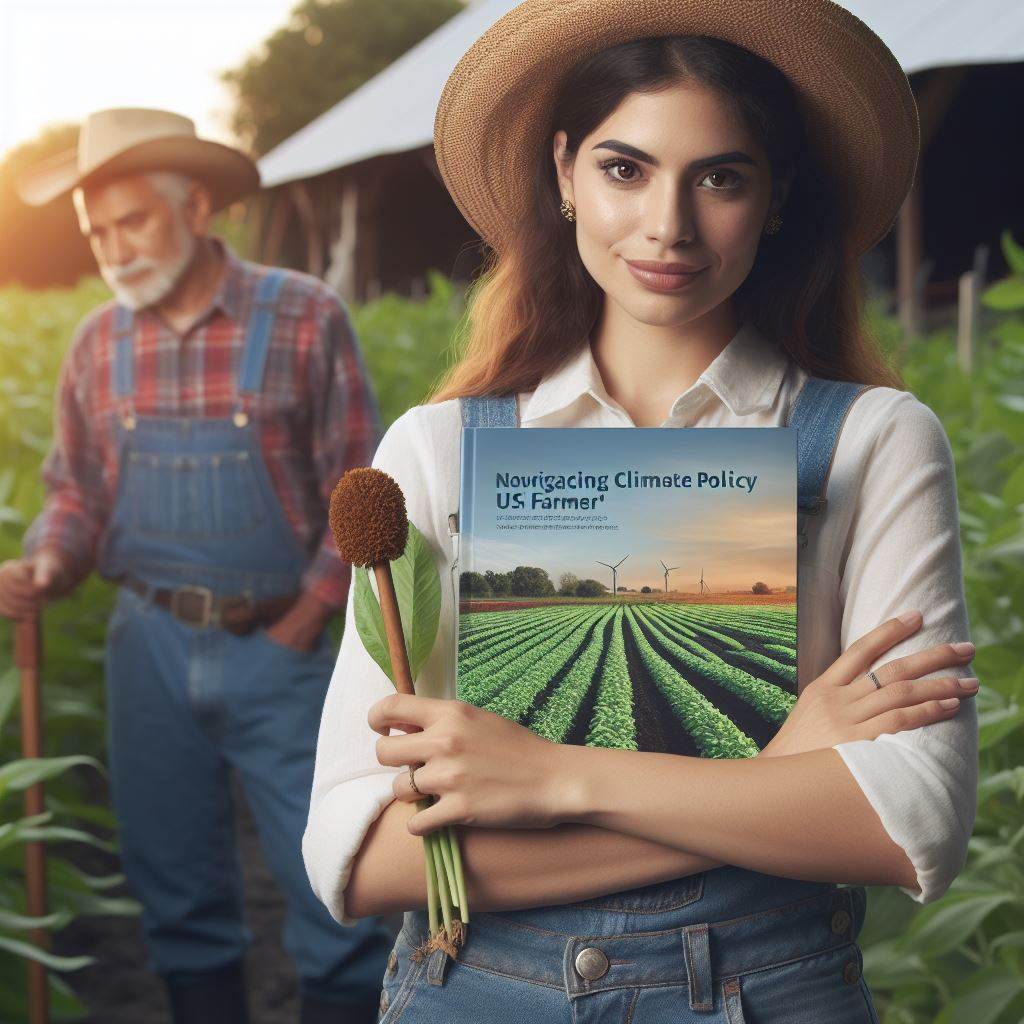Introduction
Global warming, characterized by the gradual increase in Earth’s average temperature, is primarily driven by human activities.
These activities, such as the burning of fossil fuels and deforestation, release greenhouse gases like carbon dioxide and methane into the atmosphere.
These gases trap heat, leading to a rise in global temperatures, a phenomenon commonly referred to as global warming.
The consequences of global warming are widespread and severe, including but not limited to, more frequent and intense heatwaves, rising sea levels, melting polar ice caps, and disruptions to ecosystems.
The importance of crop yields in US farming
Crop yields are of paramount importance in US farming for several reasons.
Firstly, they directly contribute to food security by ensuring an adequate and stable food supply for the population.
Maintaining robust crop yields is essential for meeting the nutritional needs of both domestic and international markets.
Secondly, crop yields play a crucial role in supporting the economy.
Agriculture is a significant sector in the US economy, providing employment opportunities, generating income for farmers, and contributing to overall economic growth.
High crop yields translate to increased profitability for farmers and greater economic prosperity for rural communities.
Additionally, the agricultural sector relies on crop yields to meet the demands of various industries, including food processing, manufacturing, and exports.
Thirdly, crop yields are essential for environmental sustainability.
Sustainable farming practices aim to maximize productivity while minimizing negative impacts on the environment.
By optimizing crop yields, farmers can reduce land, water, and energy usage, mitigate greenhouse gas emissions, and preserve natural resources for future generations.
Moreover, healthy and productive crops contribute to ecosystem health by maintaining soil fertility, promoting biodiversity, and preventing soil erosion.
Overall, crop yields are fundamental to the success and sustainability of US farming, with far-reaching implications for food security, economic prosperity, and environmental conservation.
Link between global warming and crop yields
The relationship between rising temperatures and agricultural productivity
- As global temperatures rise, it leads to a decline in crop yields due to heat stress.
- Higher temperatures affect the pollination process, resulting in reduced fruit set and lower crop yields.
- Rising temperatures also increase the evaporation rate, leading to soil moisture depletion and reduced crop production.
- Warmer temperatures can accelerate crop development, causing plants to mature faster and resulting in smaller yields.
- Heatwaves during critical growth stages can damage crops, leading to reduced productivity and economic losses.
Changes in rainfall patterns affect crop yields
- Global warming can alter rainfall patterns, affecting water availability for crops.
- Changes in precipitation patterns may lead to droughts or excessive rainfall, both of which can impact crop yields.
- In regions experiencing increased rainfall, plants may suffer from waterlogging, reducing nutrient uptake and negatively impacting yields.
- Droughts can result in water scarcity, depriving crops of necessary moisture for growth and causing significant yield reductions.
- Erratic rainfall patterns make it challenging for farmers to plan planting and irrigation, further affecting crop yields.
The impact of extreme weather events on crops
- Global warming increases the frequency and intensity of extreme weather events such as hurricanes, floods, and storms.
- These events can cause physical damage to crops, leading to reduced yields and significant financial losses for farmers.
- Flooding can result in soil erosion and nutrient loss, affecting plant growth and productivity.
- Strong winds associated with extreme weather events can break stems, uproot plants, and destroy crops.
- Extreme heatwaves can cause crop wilting, leaf scorching, and premature aging, ultimately reducing yields.
In fact, global warming poses significant challenges to crop yields and agricultural productivity.
Rising temperatures directly impact crops through heat stress, altered pollination processes, and soil moisture depletion.
Changes in rainfall patterns further exacerbate the issue, with droughts and excessive rainfall negatively affecting crop health and yields.
Additionally, extreme weather events lead to physical damage and economic losses for farmers.
Addressing global warming through sustainable practices and mitigation strategies is crucial to ensure the future of US farming and secure food production for the growing population.
Read: Adaptive Farming in a Changing Climate
Current challenges faced by US farming
Specific regions in the US affected by global warming
- The Midwest: Global warming has caused an increase in extreme weather events such as droughts and floods, affecting crop production in states like Iowa and Illinois.
- The Southwest: Rising temperatures and water scarcity have led to reduced crop yields in states like California and Arizona.
- The Southeast: Increased precipitation and higher humidity levels have contributed to the spread of pests and diseases, impacting crops in states like Florida and Georgia.
- The Great Plains: Changing rainfall patterns and heat stress have affected crop production in states like Kansas and Nebraska.
The consequences of decreased crop yields for farmers
- Financial burden: Farmers face significant financial losses when their crop yields are reduced due to global warming, affecting their livelihoods and ability to support their families.
- Increased production costs: Farmers may need to invest in irrigation systems, drought-resistant seeds, or pest control methods to adapt to the changing climate, leading to higher expenses.
- Food insecurity: Decreased crop yields can result in food shortages and price hikes, impacting both farmers and consumers.
- Job losses: As farmers struggle with reduced harvests, they may be forced to lay off workers, resulting in unemployment and economic instability in rural communities.
The economic implications for the agricultural industry
- Decreased profitability: The agricultural industry suffers financially when crop yields decline, leading to lower revenues for farmers and related businesses such as equipment manufacturers and grain processors.
- Reduced exports: With decreased crop yields, the US may struggle to meet the global demand for agricultural products, resulting in a decline in export opportunities and potential trade imbalances.
- Increased dependence on imports: As domestic crop production decreases, the US may rely more on imported goods to meet its food and agricultural needs, impacting national security and trade relationships.
- Shifts in land use: Farmers may be forced to switch to alternative crops or even abandon farming altogether as certain regions become unsuitable for traditional agriculture, resulting in changes in rural landscapes and economies.
In short, global warming poses significant challenges to US agricultural activities, affecting specific regions, decreasing crop yields, and leading to economic implications for the agricultural industry.
It is crucial for farmers, policymakers, and stakeholders to prioritize sustainable practices and adaptation strategies to mitigate the impacts of global warming on crop production and secure the future of US agriculture.
Read: Eco-Pest Control in Modern Farming
Discover More: Soil Health Tech to Combat Climate Change
Strategies and Innovations for Adapting to Global Warming
Examples of Sustainable Farming Practices
- Conservation tillage method reduces soil erosion and preserves soil moisture.
- Organic farming practices minimize greenhouse gas emissions and utilize natural fertilizers.
- Agroforestry integrates trees with crops, providing shade and improving soil fertility.
- Precision agriculture employs technology to optimize water and nutrient usage, reducing waste.
- Aquaponics combines fish farming and hydroponics, creating a sustainable closed-loop system.
Importance of Crop Diversification and Resilient Seed Varieties
- Growing a variety of crops minimizes the risk of huge losses due to climate-related disasters.
- Resilient seed varieties are genetically enhanced to withstand extreme temperatures and pests.
- Crop diversification ensures food security, as diversified farms are less vulnerable to climate change impacts.
- Rotating crops helps prevent soil depletion and improves overall soil health.
- Resilient seeds can adapt to changing climate conditions, enabling farmers to maintain productivity.
Role of Technology in Improving Crop Yields Despite Changing Climate Conditions
- Climate-smart technologies provide real-time data on weather patterns, enabling precise decision making.
- Drones and satellites analyze crop health, moisture levels, and nutrient deficiencies, aiding precision farming.
- Genomic breeding techniques help develop heat, drought, and disease-resistant crop strains.
- Irrigation technologies, like drip systems, optimize water usage and minimize evaporation.
- Indoor and vertical farming utilize controlled environments, reducing the vulnerability to extreme weather events.
In general, adapting to global warming requires innovative strategies and practices.
By implementing sustainable farming methods, such as conservation tillage and organic farming, the effects of global warming can be mitigated.
Crop diversification and resilient seed varieties play a crucial role in building resilience against changing climate conditions.
Additionally, technology, with its various applications, empowers farmers to enhance crop yields and make informed decisions.
Embracing these strategies and innovations will ensure the future of US farming in the face of global warming’s challenges.
Read: Agroforestry: Green & Productive

Learn More: Climate Change: Strategies for Water Preservation
Explore Further: Flood-Ready Farming: Essential Tips
Policies and government initiatives addressing global warming and farming
Existing regulations and initiatives aimed at reducing greenhouse gas emissions
- The Environmental Protection Agency (EPA) has implemented the Clean Power Plan to reduce carbon emissions from power plants.
- The EPA has also set emission standards for vehicles and implemented the Renewable Fuel Standard to promote biofuel production.
- The Paris Agreement aims to limit global warming to well below 2 degrees Celsius and encourages countries to reduce greenhouse gas emissions.
The role of research and development in finding sustainable solutions
- Research and development play a crucial role in finding sustainable solutions to mitigate global warming and its impact on agriculture.
- Scientists are studying ways to develop climate-resistant crops that can withstand extreme weather conditions.
- Research is being conducted to find alternative farming practices that reduce greenhouse gas emissions, such as organic farming and precision agriculture.
The effectiveness of government support programs for farmers affected by global warming
- Government support programs, such as crop insurance and disaster relief, provide financial assistance to farmers affected by extreme weather events.
- The USDA offers grants and incentives for adopting sustainable farming practices that mitigate climate change effects.
- However, the effectiveness of these programs is debatable, as some farmers face challenges accessing and utilizing these resources.
In a nutshell, policies and government initiatives play a crucial role in addressing the challenges of global warming and its impact on farming.
By implementing regulations and initiatives aimed at reducing greenhouse gas emissions, such as the Clean Power Plan and emission standards for vehicles, the government takes steps towards mitigating climate change.
Research and development are essential in finding sustainable solutions.
Studying climate-resistant crops and alternative agricultural activities practices can help minimize the negative effects of global warming on crop yields.
Government support programs provide assistance to farmers affected by extreme weather events and encourage adoption of sustainable farming practices.
However, the effectiveness of these programs needs continuous evaluation and improvement.
Transform Your Agribusiness
Unlock your farm's potential with expert advice tailored to your needs. Get actionable steps that drive real results.
Get StartedOverall, a comprehensive approach involving regulations, research, and support is necessary for the future of US farming in the face of global warming.
Read: Climate & Crops: Adapting Farming
Conclusion
Recap of Key Points
Throughout this blog post, we’ve explored the profound impact of global warming on US farming.
Longer growing seasons, increased pest pressure, and heightened disease risks are among the challenges farmers face.
To mitigate these challenges, farmers must implement pest control measures, adopt resilient farming practices, and invest in new technologies.
Policymakers play a critical role in supporting farmers by providing funding for research and incentives for sustainable practices.
Collaboration between farmers, scientists, and government agencies is essential for finding innovative solutions to climate change’s impacts on agriculture.
Together, we can navigate these challenges and ensure the resilience of our agricultural systems.
Emphasizing Urgency
The urgency of addressing global warming for the future of US farming cannot be overstated.
Climate change poses a direct threat to food security and livelihoods.
As temperatures rise and weather patterns become more unpredictable, the risks to crop yields and livestock productivity escalate.
Failure to act swiftly could result in significant economic losses and food shortages.
Every day counts in our efforts to combat climate change and protect the future of US farming.
It’s imperative that we take decisive action now to mitigate its effects and build resilience within our agricultural sector.
Encouraging Support
We urge readers to stay informed about the impacts of climate change on agriculture and support efforts that promote climate resilience.
By staying engaged with scientific research, advocacy initiatives, and policy developments, individuals can contribute to meaningful change.
Whether through voting for climate-conscious leaders, supporting sustainable farming practices, or participating in community initiatives, every action matters.
Furthermore, supporting farmers in their transition to climate-resilient practices is crucial.
This can include purchasing locally grown produce, advocating for fair agricultural policies, and investing in agricultural innovation.
Together, we can work towards a future where US farming thrives in the face of climate change.
By prioritizing sustainability, resilience, and collective action, we can safeguard our food supply and agricultural heritage for generations to come.
In closing, let us remain vigilant, proactive, and united in our efforts to address global warming’s impact on US farming.
The stakes are high, but with determination and collaboration, we can create a more sustainable and resilient agricultural future.




